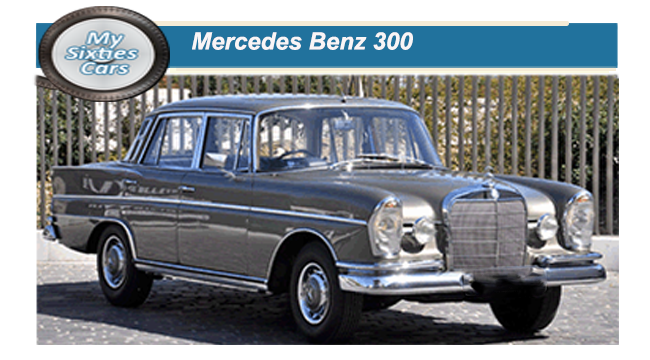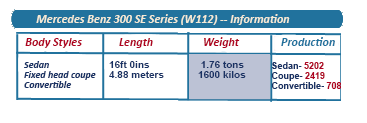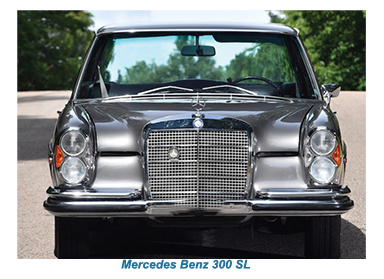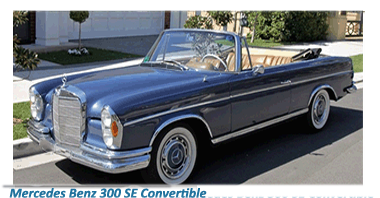
Mercedes' new flagship line for the early Sixties was a mix of company heritage and state-of-the-art features.
The 300's design was long and chrome-laden with long overhangs beyond the front and rear axles, while the radiator, headlights, and windshield were big and upright. Mechanic ally, the 300 Series was given everything to differentiate it from the lesser 200 Series.
Mercedes had to justify a price tag almost double that of the 200, even though the cars, unusually for the brand, shared a chassis.
This arr
ally, the 300 Series was given everything to differentiate it from the lesser 200 Series.
Mercedes had to justify a price tag almost double that of the 200, even though the cars, unusually for the brand, shared a chassis.
This arr angement that pneumatic suspension, power steering, four-wheel disc brakes and automatic transmission were standard.
The 300SE was an undoubted eye-catcher, and Mercedes emphasised its stance by fitting large diameter wheels offset by whitewall tires.
Despite its racy appearance, the 300SEC was all about making refined, comfortable progress rather than teeth gritting action.
angement that pneumatic suspension, power steering, four-wheel disc brakes and automatic transmission were standard.
The 300SE was an undoubted eye-catcher, and Mercedes emphasised its stance by fitting large diameter wheels offset by whitewall tires.
Despite its racy appearance, the 300SEC was all about making refined, comfortable progress rather than teeth gritting action.
![]()
 The 300 weighed in at an imposing 3,505 pounds (1,590 kg.) Totomg that kind of girth vame at a price, with returned fuel consumption that was no less than appalling —just 12 mpg (17 litres per 100 km) on average.
And that at a time when fuel prices were just beginning to creep up.
The 300 weighed in at an imposing 3,505 pounds (1,590 kg.) Totomg that kind of girth vame at a price, with returned fuel consumption that was no less than appalling —just 12 mpg (17 litres per 100 km) on average.
And that at a time when fuel prices were just beginning to creep up.
 The principal reason for such dubious fuel consumption was that even the straight-six overhead-valve enginethat powered the 300 may have been simply not powerful enough to puss the 300 forward.
To bolster the image of the 300, two-door coupe and cabriolet versions were released in 1962, a year after the sedan (saloon).
Looking back today, the 300SEC (coupe) was a wonderfully sleek design, with pillarless side windows and delicate tail fins.
The interior was garnished with leather and burr walnut, dominated by four oversized padded seats with large fold-down armrests between them.
Like a true classic, the 300’s unadventurous design has aged well, and today the big Mercedes, particularly the coupe , still carries an imposing and desirable look.
The principal reason for such dubious fuel consumption was that even the straight-six overhead-valve enginethat powered the 300 may have been simply not powerful enough to puss the 300 forward.
To bolster the image of the 300, two-door coupe and cabriolet versions were released in 1962, a year after the sedan (saloon).
Looking back today, the 300SEC (coupe) was a wonderfully sleek design, with pillarless side windows and delicate tail fins.
The interior was garnished with leather and burr walnut, dominated by four oversized padded seats with large fold-down armrests between them.
Like a true classic, the 300’s unadventurous design has aged well, and today the big Mercedes, particularly the coupe , still carries an imposing and desirable look.
 Despitebeing among the earliest Sixties Mercedes-Benz models, the 300SL Roadster puts later models to shame with its good looks and sonic speeds.
However, although the looks alone are captivating, it was the 300's speed and power that won the day. The Coupe engine was capable of being tuned up to reach an impressive power output of 240bhp, allowing it to hit a top speed of 250 km/h and accelerate from 0-100 km/h in just 7.6 seconds on track conditions- an impressive figure even by today’s standards.
Despitebeing among the earliest Sixties Mercedes-Benz models, the 300SL Roadster puts later models to shame with its good looks and sonic speeds.
However, although the looks alone are captivating, it was the 300's speed and power that won the day. The Coupe engine was capable of being tuned up to reach an impressive power output of 240bhp, allowing it to hit a top speed of 250 km/h and accelerate from 0-100 km/h in just 7.6 seconds on track conditions- an impressive figure even by today’s standards.






